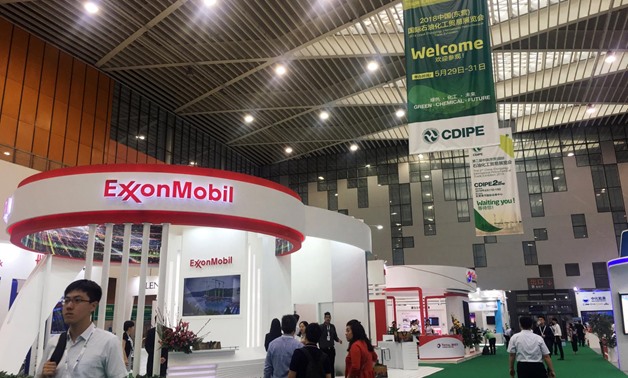
A booth of U.S. major ExxonMobil is seen at the China (Dongying) International Petrochemical Trade Exhibition in Dongying, Shandong province, China May 29, 2018. Picture taken May 29, 2018. REUTERS/Chen Aizhu
DONGYING - 31 May 2018: ExxonMobil Corp’s (XOM.N) global oil marketing team stormed into China this week hoping to elbow aside rivals and gain access to the nation’s “teapot” refining market, executives told Reuters.
The push by Exxon, the world’s biggest oil and gas company by market value, to court the independent refiners, known as teapots, illustrates the clout they are exerting on the global oil market since winning crude import licenses from the government in 2015. The refiners are big foreign crude buyers in a country that is now the world’s largest oil importer.
To make up for a late arrival, Exxon this week sent a dozen traders and marketers, including global crude marketing manager Thomas Martenak, to an oil trade show in Dongying, a hub for the independent refiners in the eastern province of Shandong.
The team included crude oil traders, products marketers and finance staff from Houston, Singapore, Thailand and Shanghai.
At a booth at the center of Dongying’s downtown exhibit hall, staff handed out gift bags containing backpacks emblazoned with the ExxonMobil logo, flanked by stands from Malaysia’s Petroliam Nasional and France’s Total (TOTF.PA) and about 20 local refiners.
On Monday evening, Exxon’s team wined and dined prospective customers and traders at a dinner attended by around 200 guests, according to multiple people who attended. Goodie bags at the party contained flasks for travel use, they said.
The marketing blitz is a departure from Exxon’s traditional methods of peddling their crude such as one-on-one meetings.
“I have never seen ExxonMobil ever do this kind of thing in my whole career,” said Lau Kay Hoe, a delegate who retired recently after more than three decades working in shipping and trading at the company.
Exxon produces 2.5 million barrels per day (bpd) of crude from Europe, Africa, the Middle East and the Americas that mainly supplies its own refining system.
The company push occurs amid a looming trade war between the United States and China, the world’s two biggest economies. The two sides agreed in talks earlier this month that U.S. energy sales were crucial to offsetting the $335 billion trade deficit the U.S. has with China, its top trading partner. [nL3N1SS1VH]
Martenak, who flew in from Houston for the event, said the firm was drawn by the growing importance of China’s independent refiners in the regional market, rather than politics.
This was the first publicity push by the oil sales and supply team in the eight years since he took over the reins as the global marketing chief, he said.
“We probably are not as fast as some of the traders ... We want to make it up quickly so we can become a major supplier in the region,” he told a seminar on Tuesday.
Martenak’s team has also met with potential teapot clients in private meetings this week, but their main purpose was to act as Exxon’s “ambassador” rather than cutting deals, he told Reuters at its booth.
New rules from the International Maritime Organization requiring ships to use low-sulphur fuel starting in 2020 will also likely boost China’s need for U.S. sweet, or low-sulphur, crude, he said.
CHARM OFFENSIVE
Exxon’s charm offensive is starting in Dongying, an oil town built in the 1960s on China’s second-largest oilfield. The city is now the country’s biggest refining center with more 32 refineries and total annual refining capacity of 69 million tonnes, or about 1.38 million bpd.
China has nearly 40 independent refiners and since winning their import quotas three years ago they now buy one-fifth of China’s crude oil imports of 9.6 million bpd.
Most of China’s teapots are in Shandong, sucking in crude from West Africa, Russia, Oman and Brazil.
Exxon’s late arrival means they face competition from global peers such as BP (BP.L) and Royal Dutch Shell (RDSa.L).
Additionally, global traders, Vitol, Trafigura and Mercuria were among the early movers to the teapot market. Their China-based traders make monthly visits to Shandong, which often involve entertaining over drinks before discussing deals. reut.rs/2J25zgH
BP’s China marketing team in Beijing and Shanghai is the largest among the international oil majors, followed by Shell.
“ExxonMobil, like Chevron, are late comers in the Shandong market,” said an independent refining executive at a plant in Dongying.
“They are very strong in global supply sources, but compared to traders like Mercuria, Trafigura and Vitol, their knowledge of the local market is not as deep.”


Comments
Leave a Comment